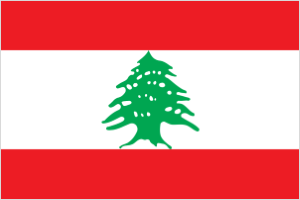Lebanon
Liban (Tiếng Việt: Li-băng; tiếng Ả Rập: لبنان Libnān; phiên âm tiếng Ả Rập Liban: [lɪbˈnæːn]; tiếng Pháp: Liban), tên đầy đủ Cộng hoà Liban (tiếng Ả Rập: الجمهورية اللبنانية al-Jumhūrīyah al-Lubnānīyah; phiên âm tiếng Ả Rập Liban: [elˈʒʊmhuːɾɪjje l.ˈlɪbnæːnɪjje]; tiếng Pháp: République libanaise), là một quốc gia Trung Đông. Liban có nhiều núi, nằm cạnh bờ biển đông của Địa Trung Hải. Nó giáp với Syria về phía bắc và Đông, và Israel về phía nam, có bờ biển hẹp dọc theo ranh giới Tây.

National flag - Wikipedia

View on Google

View Map
Lebanon is a small country at the eastern end of the Mediterranean, bordered by Syria and Israel. The people of Lebanon are mostly Arabs, belonging to a great variety of religous groups. Lebanon was once the cultural and business centre of the Near East. But in 1975, tensions between Muslims and Christian groups led to the outbreak of a violent civil war which almost destroyed the country. Peace terms were agree in 1989 and some stability was restored.
Druzes: The Druze faith is an offishoot of Islam that is now considered a religion in its own right. There are about 200.000 Druzes in Lebanon, mainly living in the southern mountains. They have many customs designed to protect their community. It is impossible to become a Druze unless you are born one, and you cannot give up your faith. Marriage is only allowed within the community to ensure that the Druze faith continues.
Religous Groups: The Lebanese population is a jigsaw of religous groups, including different Christian and Muslims sects. The largest Christian group is the Maronites, who practise a form of Catholicism. Other Christian groups include the Greek Orthodox and Greek Catholics. The Muslim are divided into the Sunnis and the Shi'as.
Rebuilding Beirut: Before the destruction in the civil War, Beirut was a cultired and lively city. It was known as the "Paris of the East" and was one of the region's most important ports and business centres. For many years the city lay in ruined, but a governmenr project to rebuild Beirut has managed centre and has succeded in attracting visistors back to the capital.
Cedar trees: The cedars of Lebanon are the country's symbol and appear on the national flag. In biblical times, great forests of cedar trees covered the slopes of the Lebanese mountains. Today, they survive only in a few protected groves. Some of these trees are more than 1.500 years old.
Tyre and Sidon: The civil war ruined Lebanon's thriving tourist industry. Attemprs are now being made to attract visitors back to the country's fine beaches and historical sites, such as the two cities of Tyre and Sidon. These were built by the Phoenicians some 3.000 years ago and were famous in Roman times for their glasswear and purple dyes.
Lebanese Food: The national dish of Lebanese is kibbe, made of lamb, burghul (cracked wheal), and onions, pounded together. The mixture is shaped into balls or parties and baked or dried. Sweet pastries, stuffed with nuts and dates and covered in honey, are also popular.